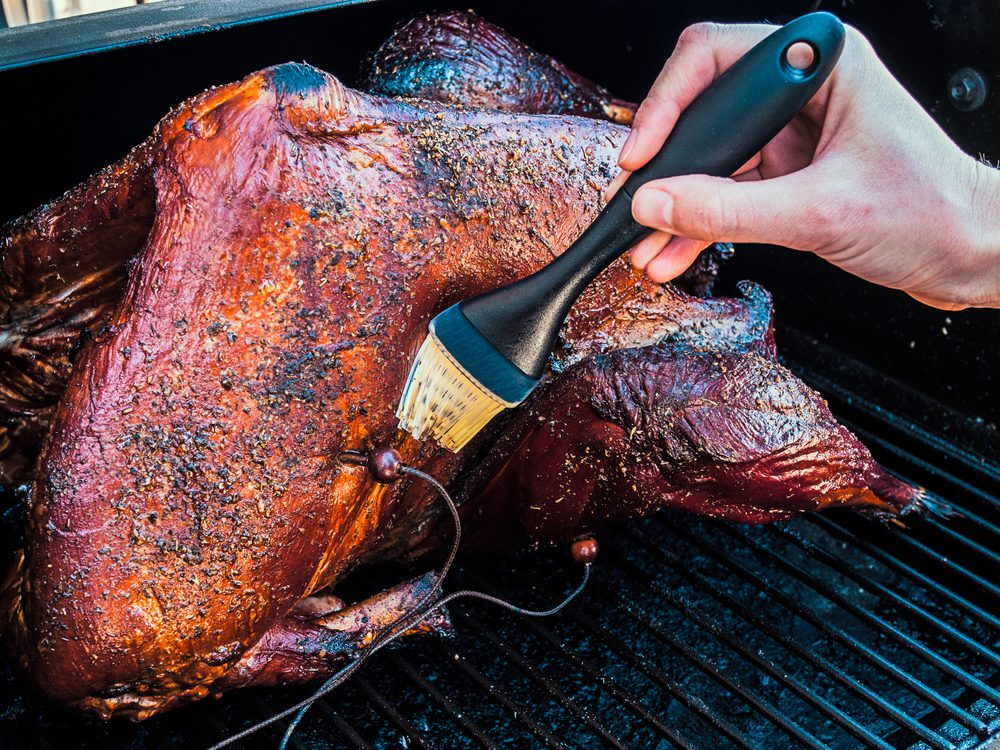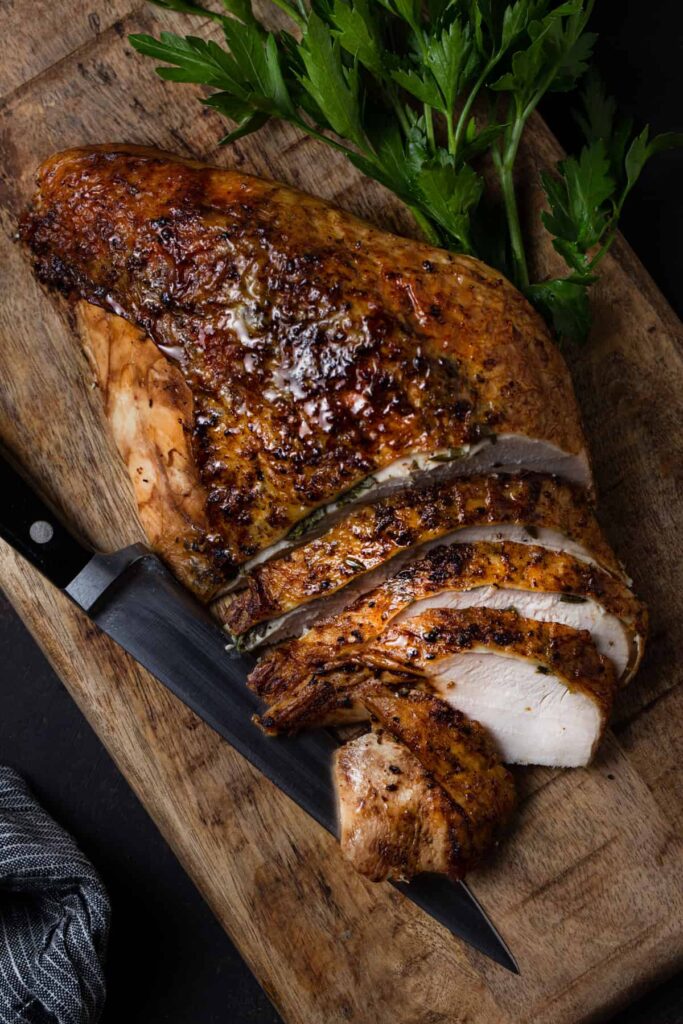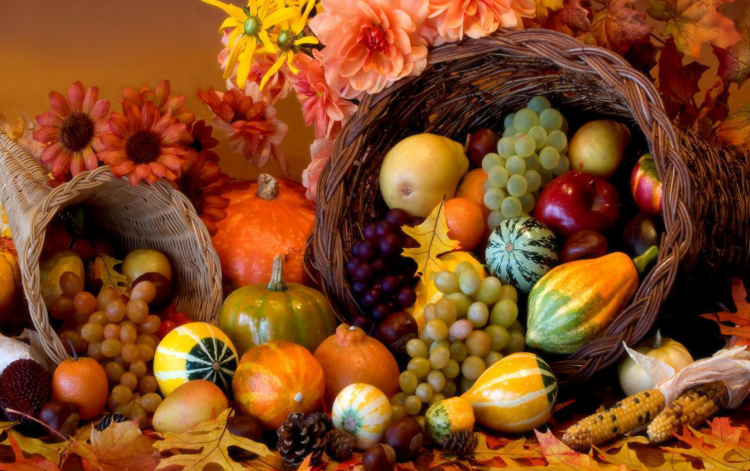
- “Turkey lurkey doo and Turkey lurkey dap, I eat that turkey, Then I take a nap.” -Poet Laureate Adam Sandler
Benjamin Franklin wanted the turkey, not the bald eagle, as America’s national bird. He lost the fight and forever relegated the gobbler to be devoured once or twice a year. For most of my life, turkey did not rank highly on my list of holiday foods. Dry and bland, its consumption around the holidays was more of a duty than a joy.
But then I discovered fried turkey injected with cajun spices and butter. Mind blown. Over time, though, the act of frying a turkey proved too laborious a task and a new method was identified — smoking. (Some people now smoke their bird and then fry it…busybodies).
Here, in a nutshell, is a smoked turkey recipe almost sure to please.
Step 1. Bird Selection
The advice is simple: Don’t smoke a big bird. You are better off buying two or three small turkeys than trying to smoke a 28-pound behemoth. Big birds cook inconsistently. For my part, I go with bone-in turkey breast because my hoity toity family (don’t tell them) won’t eat dark meat.
Step 2. The Wet Brine
Turkey dries out. It’s a fact of life on par with death and taxes. Brining helps keep a bird moist and delectable, while imparting some flavor. There are a vast assortment of brine recipes and store bought mixes. No matter what you throw in salt and sugar are key ingredients. Here’s my jam:
- 4 quarts water
- 1 cup kosher salt
- 1 cup granulated sugar
- 2 sweet onions (cut into quarters)
- 5 garlic cloves
- 2 lemons squeezed and thrown in brine for good measure
- 2 oranges squeezed and thrown in brine for good measure
- 5 sprigs of rosemary
- Half a cup of black peppercorns
(One alternative is to use a gallon of sweet tea instead of the water. If you go this route, skip the added cup of sugar in the above recipe.)
Boil the water and add the salt and sugar to dissolve before adding the other ingredients. Once its cooled, add your brine and a copious amount of ice to a food safe container before adding your turkey. Let it sit in the refrigerator for 24 hours. I generally do this step on Tuesday.
Step 3. The Dry Brine
After 24 hours in the wet brine, remove your turkey(s) and pat dry, inside and out, with paper towels. A dry brine is what it sounds like — a salt-based mixture of seasoning minus the wet. This will be your primary seasoning during the smoke. A dry brine, by itself, can also help with your dry turkey problem if you decide to forego the hassle of the wet brine…or run out of time in the lead up to the big day.
Below are two dry brine recipes — one a simple herb mixture and one a cajun variety. I generally will apply the dry brine on Wednesday.
Herb Dry Brine:
- 3 Tbsp. kosher salt
- 3 Tbsp. dark brown sugar
- 2 Tbsp. of fresh thyme leaves
- 2 tablespoons of fresh rosemary leaves
- 2 tsp. rubbed sage
- 1 1/2 tsp. black pepper
- 1 tsp. garlic powder
Cajun Dry Brine:
- 3 Tbsp. kosher salt
- 3 Tbsp. dark brown sugar
- 2 tsp. paprika
- 2 tsp. dried oregano
- 1 tsp. black pepper
- 1/2 tsp. cayenne pepper
- 1 tsp. onion powder
Place your ingredients in a spice grinder (or food processor and blend together). Apply dry brine. You will want to get the seasoning mixture underneath the skin of the turkey without removing the skin. This involves performing invasive surgery on the bird by running your hand under her skin. You will also want to season the outside of the skin.
Once the dry brine is applied, stick the turkey in the refrigerator uncovered. This will help dry out the skin. Dry skin equals crispy skin. Wet skin equals flabby skin. No one likes flabby skin.
Step 4. The Smoke
I always save some of my brine, mix with melted butter and inject into the turkey before putting onto the smoker. This is not a necessary step, though. I also always put dollops of room temperature butter under the skin of the turkey before putting on the smoker. This step will both baste the bird while cooking and also help with “operation crispy skin.” Apply toothpicks through the perimeter of your turkey skin. This will keep it taught and prevent shrinkage. Without it, your ol’ girl’s skirt will rise throughout the cook.
For poultry, I use a mixture of apple and pecan wood for smoking. Stronger flavored woods tend to overpower a bird. Get your smoker to 300-325 degrees. Turkey does not do as well with “low and slow” as proteins with more intermuscular fat (e.g. brisket or a pork butt).
Watch for “blue smoke” before putting your turkey on the smoker. Thick gray or white smoke bellowing from a smoker is a sign of wood that has not fully combusted. It can lead to acrid tasting meat.
Make sure that there is some separation between your heat source and your gobbler. If you are using a horizontal smoker, you’re covered. If you are using a vertical smoker, like a Big Green Egg, you will want to use a plate setter that prevents direct heat on the bottom of your bird. Finally, no matter your setup, you will want to have a water pan in with the turkey.
Step 5. Pulling, Resting, Devouring
A good leave in meat thermometer will benefit you greatly. If not, a thermapen-style will do in a pinch. Smoking a medium sized turkey is a 2.5-3 hour process generally, but you will want to rely on the internal temperature of the bird to dictate when to pull. During the process of the cook, you might consider basting every 45 minutes or so with some butter. Have I mentioned butter?
If you Google “what temperature do I pull a turkey from cooking?” the Nellies at the USDA will tell you the answer is 165 degrees measured at the deepest part of a turkey breast. This is the temperature at which certain food borne bacteria dies.

BUT, if you pull your turkey from the smoker at 165 degrees, it will continue cooking well into the upper 170s (and past the point of a juicy bird). This is because of residual heat that builds during the cook. Instead, pull your turkey at 155 degrees. While it is resting, it will get up to 165 degrees internally and your finished product will be much better. Some pitmasters pull even earlier.
Resist the urge to immediately carve the turkey once pulled off the smoker. Let it rest 20-30 minutes before slicing. Instead of slicing the breast while on the carcass, remove it entirely from the bone by slicing next to the breast bone and following the contour to the side of the turkey. Then slice across the removed breast.
Now, load your plate with dressing, mac-n-cheese, cranberry sauce, and all the other fixins’ and enjoy. Happy Thanksgiving!











